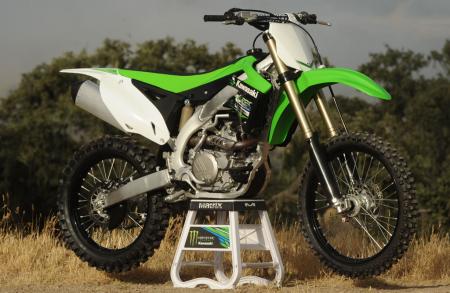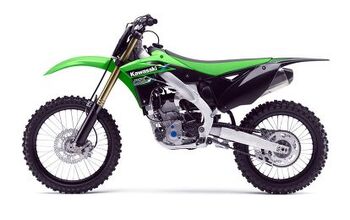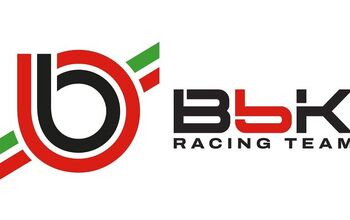2013 Kawasaki KX450F Review - Motorcycle.com
When you have a bike that has been as successful as the KX450F model has been for Kawasaki, it makes you wonder just what is left that could be made better. The last few years we have seen the KX450F on top of the podium in both Supercross and Outdoor Motocross with countless victories. However, Kawasaki has proven that even with the economic troubles the world has faced in the last few years it is a company that does not rest on its laurels and will continue to move forward with new and exciting features on all its off-road models.
Kawasaki decided that it already had a very good engine and chassis set up from last year’s model, so these two aspects of the bike only received minor updates for 2013 to improve reliability and rider friendliness.
The biggest change that Kawasaki made to the 2013 KX450F is the inclusion of KYB’s new Pneumatic Spring Fork (PSF). While the 2013 KX450F isn’t the only motorcycle in its class to come stock with this type of fork, KYB specially designed the set that graces the Kawasaki. This motorcycle has the highest level of rider adjustability, both with this new fork and the electronics package that come stock on this bike.
The all new PSF fork is a work of art. The 48mm KYB stanchions use pressurized air to replace traditional metal coil fork springs. The PSF is said to weigh 1.7 lbs less than last year’s KYB fork, and the reduced weight and inertia of the air spring gives it a smoother feel which translates into better handling. Some other benefits of this air spring fork are better bottoming resistance, reduced oil contamination due to the lack of spring friction, and very easy tuning for all riders. All you need is a hand air pump. The DLC coating on the fork sliders also returns for 2013, as does the inner Kashima Coat Treatment to reduce drag and improve fork action.
To complement the new fork, the 2013 KX comes with one of the best rear shocks in the industry. The Kashima-coated shock features a beefy 50mm piston which increases the reliability and consistency of the action of the shock. Working in unison with the rear shock is a new swingarm which features a larger front casting that extends further down the length of the swingarm spars. This new casting improves the strength and rigidity of the swingarm and reduces the side flex some riders feel on acceleration bumps. For smaller riders, Kawasaki offers a rear suspension tie rod for purchase that is 1mm longer than stock which translates into a 4mm reduction in ride height, which can affect the KX’s steering for further adjustability.
Rider ergonomics can be customized by the handlebar’s placement in adjustable clamps, with four possible positions depending on rider preference. This is also the only bike in its class to come stock with adjustable footpegs; they have two different positions. By adjusting the handlebar position and the footpegs, a rider can have a number of different settings within minutes.
The KX450F has had a very strong motor for a number of years, so for 2013 only a few tweaks were necessary. As most riders aren’t able to handle all of the power that a 450cc motorcycle puts out, the best thing that can happen is for the power to be made more useable. This involves smoothing out the power delivery so it is easier to ride. For 2013, Kawasaki has improved the throttle response with a revised valve lift and also a revised piston crown. These changes help make the KX450F easy to ride and allow a rider to short shift so the power is very manageable.
To work in unison with the strong motor is one of the best stock ignition systems in the motocross world. The ECU is fully reprogrammable with unlimited custom maps that can easily be created by using the Kawasaki Racing Software Calibration Kit. This is the same tool the factory team uses and can be purchased at your local dealer.
For really quick tuning, the Digital Fuel Injection (DFI) system comes stock with three different pre-programmed settings on plug-in couplers. These couplers can be changed in seconds on the side of the track to give riders the power delivery they prefer. There is a standard coupler, a hard-terrain coupler and a soft-terrain coupler.
Also, like last year, the KX450F is the only production bike to have a launch control button within a rider’s easy reach on the handlebars. By selecting the button on the starting line, a rider can instantly retard the ignition in first and second gears for less wheelspin and maximum traction off the gate. When the rider shifts to third gear, the launch mode shuts off and the ignition returns to normal. This device is the same system the factory team uses and it really does give a KX450F rider a big advantage on the all-important starting line.
Also new for 2013 are longer grips that extend further toward the center of the handlebars. The grips also feature a different pattern and a softer material so they’re much easier on a rider’s hands. Another really cool change on this bike is the blue finish on the oil cap and the two caps on the generator cover. These match the blue anodized finish on the suspension adjusters and really make the bike look clean. These changes go well with the black rims and the new white rear fender. With its lime green plastics and all of the changes I just mentioned, this bike looks fast just sitting on the stand.
The track Kawasaki chose for this media launch was Zaca Station MX Park located just north of Santa Barbara, California. It is a very unique test track that features everything you could want on a track. It has steep hills, big jumps and flowing corners and the dirt that ranges from harder clay to loamy sand.
I felt extremely comfortable on the 2013 KX450F right from the start. It feels a little taller than most 450 MXers, but it was a good fit for my six-foot body. I rode most of the first day with the standard DFI coupler and stock suspension settings. After I got more comfortable with the track, I began to experiment with different settings, and it really showed just how easy this bike is to adjust.
With the steep down-hills and bigger jumps, I initially wanted the front forks to be a little stiffer. We tried some different clicker settings but it just wasn’t enough. In the past this would mean a lengthy spring change and wasted time, well not anymore with this bike. By simply adding two psi of air, the forks were stiffer and I was back on the track before I could even drink my water, it was amazing.
And it wasn’t just the quick adjustability of the PSF for that impressed me; it was how well it worked on the track. The action of this fork is extremely smooth and forgiving on everything from small, choppy bumps to hard landings off big jumps. It felt great, and as the track dried out in the afternoon and got slippery, I had that added air taken out so the fork was a little softer. This change in conditions replicated the second motos at your local track. Imagine being able to change the fork that much between motos. It certainly gives you an edge over the competition.
On the motor side of things, I felt it to be really smooth and the power to be very useable. Again, after some time on the track I had Kawasaki change the coupler from the stock, standard one to the hard-terrain one. This quick change worked great on the drying track and the bike hooked up great. The second day, in the morning when the track was soft and wet, we went to the soft terrain coupler for a little quicker throttle response, and that change was amazing as well. Being able to change almost every aspect of this bike in a matter of minutes definitely gives a rider added confidence despite variable conditions.
At $8,699, the KX is priced equal to its competition, but when you sit down and compare just what you get for that price, its value is unmatched. After two days of riding the new KX450F, it’s easy to see why it has been so successful on the race track over the last few years. And it just got better.
As multi-time motocross champion Jeff Emig said after riding this bike for the first time, “This is the bike for 2013.” I think Emig is right.
More by Chris Pomeroy





































Comments
Join the conversation